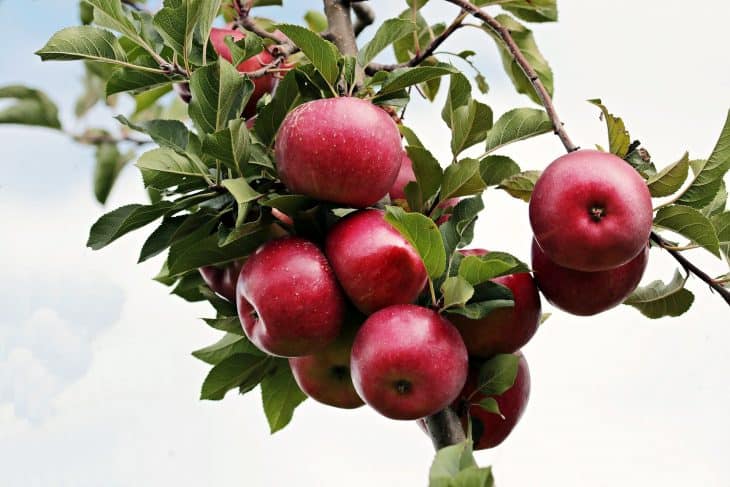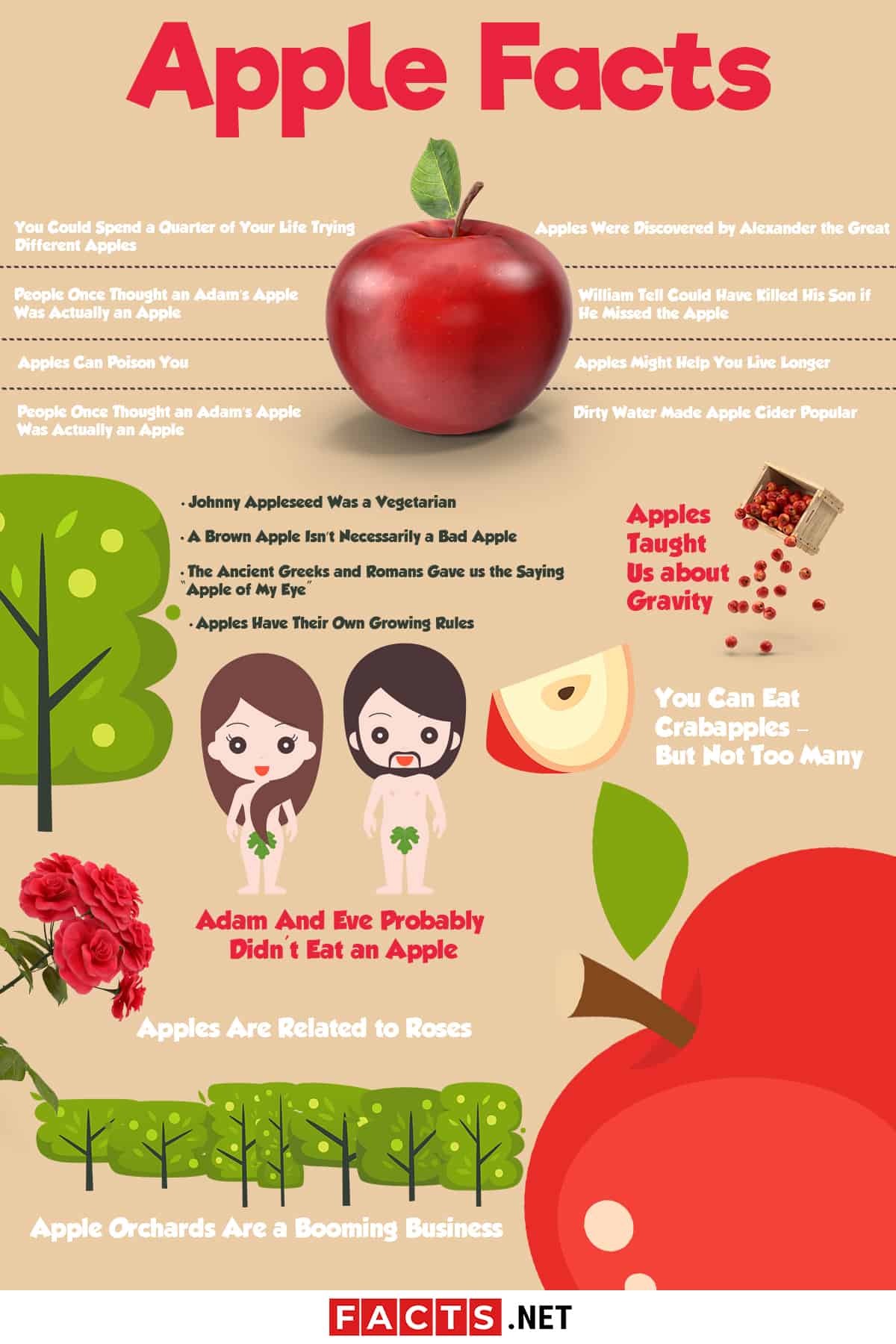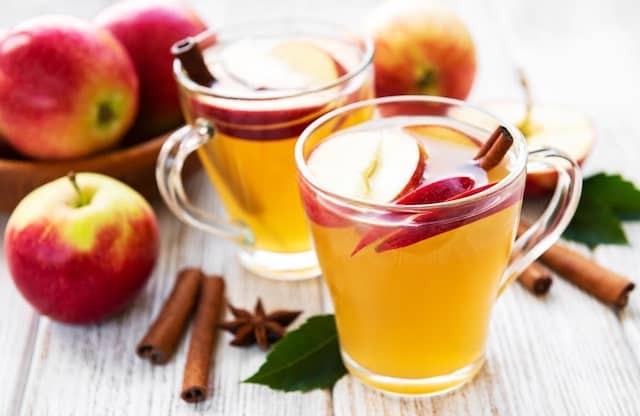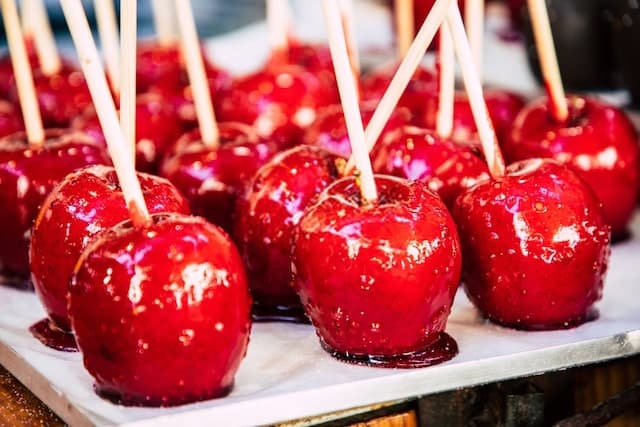
- Scientific Name: Malus domestica
- Kingdom: Plantae
- Family: Rosaceae
- Largest Producers: China, United States
- Colors: Red, Green, Yellow
- Originated: Central Asia
- Benefits: Protect bones, prevent cancer, lower cholesterol
- Types: More than 7,500
- Calories: Average 70 per apple, but some classify apples as “negative calories”
- Uses: Eat raw, Make Cider or Juice, Applesauce, Baking Ingredient
- Types: You Could Spend a Quarter of Your Life Trying Different Apples
- History: Apples Were Discovered by Alexander the Great
- Tales: People Once Thought an Adam’s Apple Was Actually an Apple
- Tales: William Tell Could Have Killed His Son if He Missed the Apple
- Health: Apples Can Poison You
- Vitamins: Apples Might Help You Live Longer
- History: Dirty Water Made Apple Cider Popular
- Science: Apples Taught Us about Gravity
- Tales: Johnny Appleseed Was a Vegetarian
- Safety: A Brown Apple Isn’t Necessarily a Bad Apple
- The Ancient Greeks and Romans Gave us the Saying “Apple of My Eye”
- Apples Have Their Own Growing Rules
- Adam And Eve Probably Didn’t Eat an Apple
- You Can Eat Crabapples – But Not Too Many
- Apples Are Related to Roses
- Apple Orchards Are a Booming Business
- Candied Apples Are a Sweet Way to Eat Healthy
Apple Facts Infographics

You Could Spend a Quarter of Your Life Trying Different Apples
According to apple facts, there are over 7,500 different types of apples in the world. Some are used for only cooking, while some are used for making apple cider. Many of them are eaten raw. If you tried a different apple every day, it would take about 20 years to try them all. Some of the most common varieties include the Red Delicious, which is great for eating raw or for making applesauce, the Golden Delicious, which is ideal for making pies, and the Granny Smith, which is great for eating, sautéing and baking.
Apples Were Discovered by Alexander the Great
Alexander the Great was a king of the Ancient Greek kingdom of Macedon and is credited with discovering apples. The story says that he found dwarfed apples in present day Kazakhstan in 328 BC. He brought them back to Macedonia with him. Eventually the apples could be found throughout Europe and colonists brought them to North America in the 17th century. The first apple orchard in North America was in Boston in 1625. It was planted by Reverend William Blaxton.
People Once Thought an Adam’s Apple Was Actually an Apple
Apple facts tell us that while all men have an Adam’s apple, many don’t know why they exist. Neither did people of the past, who came up with a unique theory to explain the bump in their throat. Legend says that when Adam and Eve were tempted in the Garden of Eden, both took a bite of the forbidden fruit. While it is never specified what type of fruit it was, many have assumed that it was an apple. While we know today that the Adam’s apple protects the vocal chords and helps to deepen a man’s voice, the original theory stated that it was caused by Adam getting a piece of apple stuck in his throat, and all men had the lump in order to remind them of Adam’s disobedience.
William Tell Could Have Killed His Son if He Missed the Apple
One of the oldest legends of our time speaks of William Tell, a hero in Switzerland who was directly involved in bringing freedom to his country. The legend tells that the Duke of Hapsburg in Austria placed a hat in the center of town. Commoners were supposed to bow to the hat, but Tell refused. As punishment, the authorities demanded that he shoot an apple off his son’s head with a bow and arrow. The legend goes on to say that not only was Tell able to hit the apple, he split it into two pieces without making a mark on his son. While the story is fun to hear, historians believe it to be a fictitious tale that was created hundreds of years later.
Apples Can Poison You
While apple facts do tell us that an apple can kill you, the chances of it happening are very, very slim. Apple pips, small and hard seeds in the fruit, do contain a bit of cyanide. However, it is a very small amount and the shell is so hard that the human body can’t break it down enough to allow the cyanide to escape. In the rare case that it is broken through, the amount of cyanide is so small that the body would not be affected. You would have to eat a large amount of apple pips and have them all break down in your system to be hurt by the cyanide.
Apples Might Help You Live Longer
You may wonder where the phrase “an apple a day keeps the doctor away” came from. The saying came long before scientists began to explore the effects of an apple on the human body, but researchers at Cornell University tested a specific chemical that is found in apples, called quercetin. They compared it to vitamin C. The chemical was administered to rats and it was shown to be more effective than vitamin C. It protects the brain from oxidative stress and, while more research is needed, it may also help to prevent the development of cancer as well.
Dirty Water Made Apple Cider Popular

One of the more interesting apple facts tells us how apple cider was once one of the most popular beverages in the United States. During colonial times, many were scared to drink water because of the high risk of disease it carried. Apples were always in abundance and many orchards grew apples only for making cider. There was actually a time when wages were paid partially in apple cider. Today, apple cider is usually only purchased in the fall, and is a popular drink at Halloween parties.
Apples Taught Us about Gravity
Everyone knows about the story of Isaac Newton and how an apple falling on his head lead to the discovery of gravity. Many simply assume that the story is made up though and was only popularized to help explain gravity. But apple facts tell us that recently discovered documents reveal comments made by Newton himself. They state that he was out in the orchard and witnessed several apples falling and it made him question why they always fell in the same way. This led him to research and hypothesize, leading to the discovery of gravity.
Johnny Appleseed Was a Vegetarian
The legend of Johnny Appleseed has more truth than you may realize. An individual named John Chapman could very well be considered the first hippy. He wanted to be at peace with the world and couldn’t bear to see an animal hurt or killed. He refused to eat them and really did travel the country, planting apple seeds on his journey. It is rumored that he did not wear shoes and wore a cloth sack instead of the normal clothing of the time. Many accounts say that he wore a tin pot on his head but this has not been proven.
A Brown Apple Isn’t Necessarily a Bad Apple
If you slice an apple and leave the pieces out long enough, they will begin to turn an unappetizing shade of brown. Many people won’t eat a brown apple because they believe it is rotten, but the truth is that the apple has simply gone through an oxidation process. The inside of an apple changes when it is exposed to air, but the fruit does not spoil this quickly. To keep sliced apples looking more appealing, you can spritz lemon juice on the surface. To keep whole apples from spoiling too soon, store them in the refrigerator.
The Ancient Greeks and Romans Gave us the Saying “Apple of My Eye”
One of the most interesting apple facts concerns the well-known expression “apple of my eye”. It is often a phrase used to describe someone who means the world to someone, like a spouse, good friend, or child. It is usually associated with feelings of love, admiration, respect and beauty. The saying has been around for quite some time and can be credited to the Ancient Greeks and Romans, who believed that the pupil of the human eye resembled an apple.
Apples Have Their Own Growing Rules
Apples are unique in many ways, but apple facts tell us that a tree that produces one certain type of apple might not produce seeds that will grow the same type of apple. In other words, if you plant a seed from apple A, a tree that grows apple B might grow instead. In apple orchards, farmers need to go through a little extra work to make sure that they grow the same type of apple each year by using root stock and then grafting a branch onto it from the specific type of apple tree they want to grow.
Adam And Eve Probably Didn’t Eat an Apple
Many know the story of Adam and Eve and the forbidden fruit. It has often been assumed that the fruit was an apple, but apple facts tell us that there is no reference to apples in the Bible regarding the Garden of Eden. A 1470 AD painting, The Fall of Man, by Hugo Van Der Goes showed the famous couple consuming an apple. The painting become so popular that an apple is still widely believed by many people to have been the forbidden fruit.
You Can Eat Crabapples – But Not Too Many

Crabapples are the only variety of apple that is native to the United States. These small apples are usually no larger than two inches in diameter and actually look like a miniature versions of regular apples bought in stores. They do have a slight unpleasant taste and can lead to a stomachache if too many are consumed, but there is nothing dangerous about eating crabapples. Crabapple trees are usually grown for their appearance rather than their fruit, though. They produce stunning flowers and can add a designer landscaping element.
Apples Are Related to Roses
Apples are part of the Rosaceae family, a medium-sized family that includes 2,830 species of flowering plants. Also included in this family are roses and edible fruits, like pears, apricots, plums, cherries, peaches, raspberries and strawberries. The flowers in this family are known for their beauty, including the apple tree which blooms in the spring. The apple trees are dormant during the winter but as soon as warm weather is detected, the tree begins to produce buds which will eventually flower. If the flower is pollinated by a bee, an apple will begin to grow.
Apple Orchards Are a Booming Business
The average size of an apple orchard in the United States is 50 acres. One of the largest and oldest apple orchards in the country is Applecrest Farms in New Hampshire. It has been operated by the same family for four generations and has been in business for over a century. The orchard grows over 40 varieties of apples and other fruits and make standard apple orchard products, including apple cider and apple donuts. The owners also allow the public to pick their own apples and enjoy the surroundings of the orchard.
Candied Apples Are a Sweet Way to Eat Healthy

In America, almost everyone has had a candied apple, especially during the fall months. In the rest of the world, these sweets are usually known as toffee apples. A Newark candy-maker by the name of William W. Kolb is credited with inventing the red candy apple. He was experimenting with red cinnamon candy and dipped apples into the mixture. He placed them in his shop’s windows for a Christmas display and sold the first batch for five cents per apple. He eventually sold thousands of his creations, and the apples could be found in candy shops across the country by the late 1940s.
Apple Facts – Facts about Apples Summary
 Apple facts tell us all about the discovery of the fruit and how they have become a staple in the American diet. These facts also talk about how apple trees are grown and how orchards are a stable business to own. Enjoy learning about this favorite fruit and all that it can do for your health, and discover some popular way of consuming apples.
Apple facts tell us all about the discovery of the fruit and how they have become a staple in the American diet. These facts also talk about how apple trees are grown and how orchards are a stable business to own. Enjoy learning about this favorite fruit and all that it can do for your health, and discover some popular way of consuming apples.
Was this page helpful?
Our commitment to delivering trustworthy and engaging content is at the heart of what we do. Each fact on our site is contributed by real users like you, bringing a wealth of diverse insights and information. To ensure the highest standards of accuracy and reliability, our dedicated editors meticulously review each submission. This process guarantees that the facts we share are not only fascinating but also credible. Trust in our commitment to quality and authenticity as you explore and learn with us.
